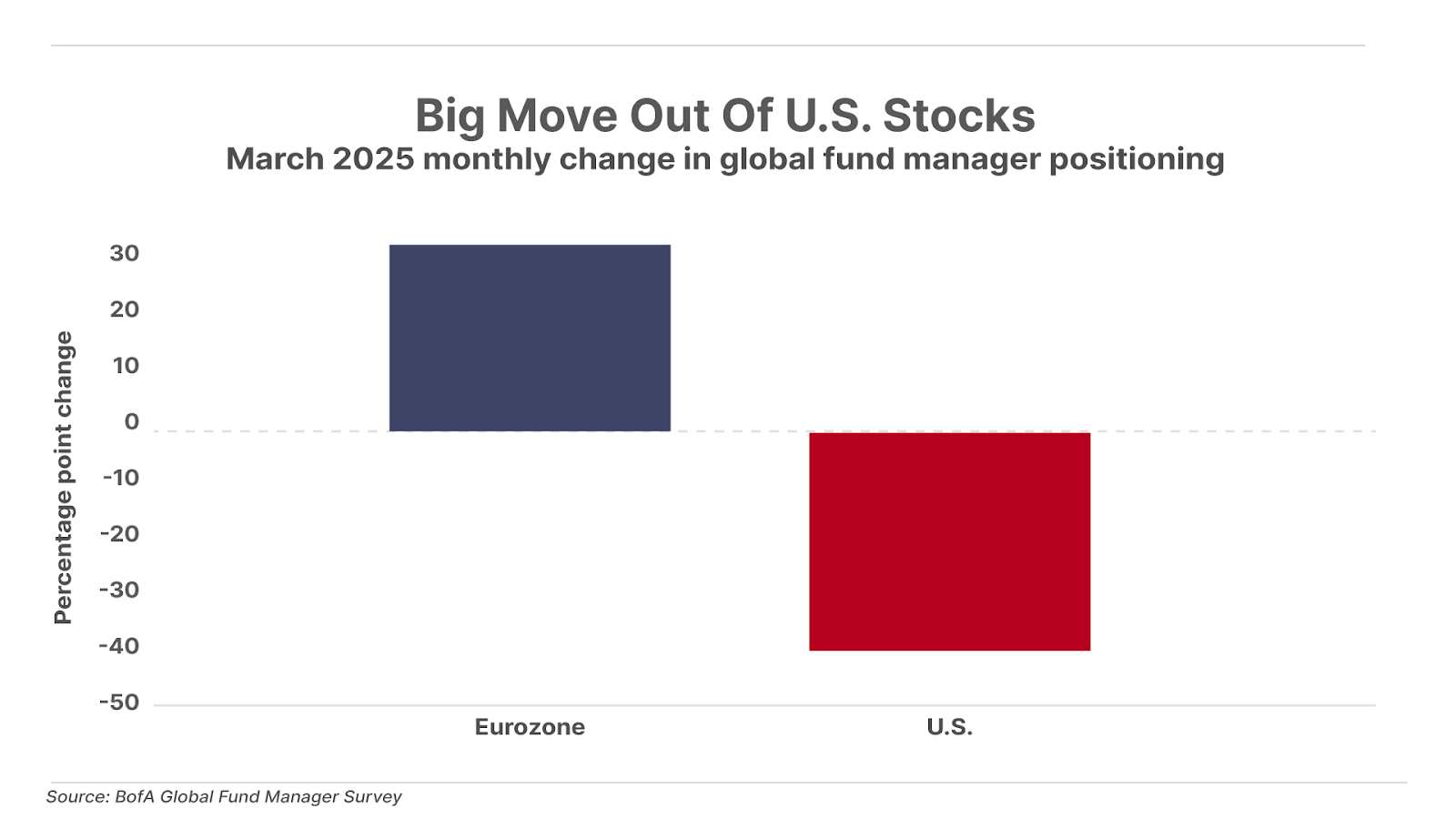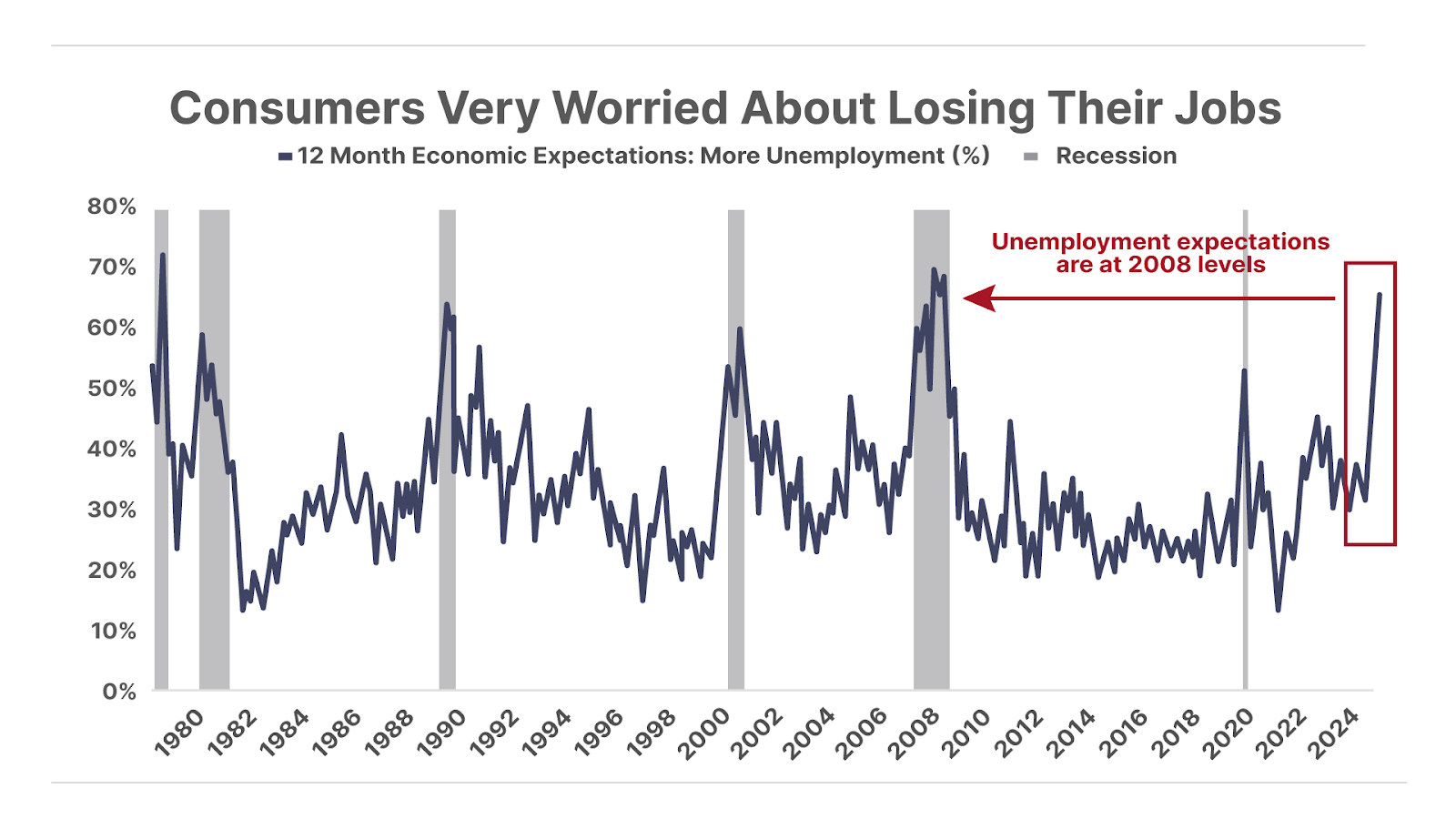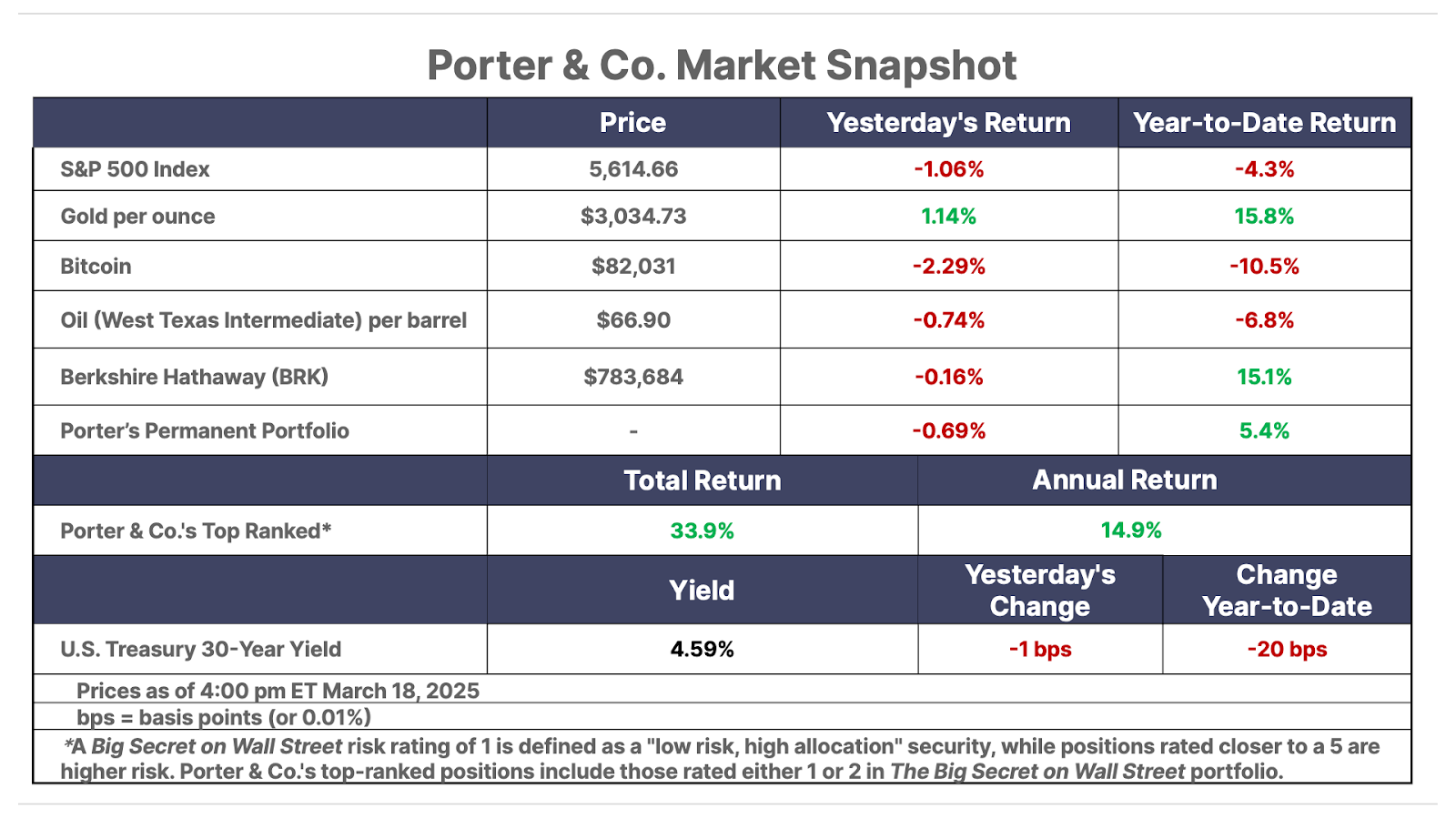Issue #32, Volume #2


Distressed Debt, The Great Reset, And More
This is Porter’s Daily Journal, a free e-letter from Porter & Co. that provides unfiltered insights on markets, the economy, and life to help readers become better investors. It includes weekday editions and two weekend editions… and is free to all subscribers.
| Readers take center stage today… Why they don’t like distressed investing and why they do… Taking issue with Porter’s “great reset”… Teach a boy to fish… |
We are turning today’s Daily Journal over to you, our readers.
Porter gets a steady stream of emails every day – most of which he personally replies to. Over the last few weeks he has written about a few topics that have generated more feedback than usual, so today we’re dedicating an entire Daily Journal to the “Mailbag.”
In the February 28 Daily Journal, Porter wrote: “This is, by far, the most valuable information we have ever published. This article will show you exactly how to beat the stock market, by a wide margin, by using corporate bonds.” He shared his personal story about investing in distressed debt and concluded – after pointing out that no one knows more about corporate bonds, particularly distressed bonds, than Distressed Investing senior analyst Marty Fridson – by saying: “if you’re not going to invest with Marty, then I want you to tell me why. Send me an email. Explain it to me…”
We received a lot of responses. Here are a few.
When I started out investing 17 years ago, I knew next to nothing. I got all of my education reading all the S&A [Stansberry & Associates] articles (sorry, I can’t bring myself to write out the full name to you… writing out your name to you is like feeding a narcissist his narcissistic candy). So, I’ve taken the teachings to heart and I trained myself to only invest in companies that I really don’t mind holding on to for decades.
For instance, I bought IBM way back at a cost price of around $100. I never minded when it went up and then down and stayed down because I reinvested the dividends and they were buying back shares. When I saw Warren Buffett sell IBM, it didn’t bother me at all. Let him leave the stock. I’ll hold on and keep taking advantage of its low price. Same with the cigarette stocks and a bunch of others.
How’s that going to work with distressed debt that has an average duration of four years? I’m not trained to invest in Peloton Interactive (PTON). To me, Peloton is a fad of high-priced exercise machines. What kind of a long-term (the only type I like) business is fancy exercise bikes that cost a ton of money going to be over decades? So, I immediately say “no, thank you” to investing in Peloton.
I understand that with bonds it’s much different. The whole bond is structured so that you only have to think in terms of its duration and that’s it. If they can make good on the bond, you make out just fine. But how does one know that when the maturity date rolls around that the company behind the bond will be able to make good on it? If they’re in big trouble prior to the maturity date, then that’s being stuck in a corner with a bond of a company that you never liked in the first place.
On the other hand, if I buy Meta (META) when it is down to around $100 per share due to Apple changing some permissions or something, I can figure that “this too shall pass” and META shares will keep making good money, and one day the downturn in their share price will end, and the downturn in price will be shown to have been an opportunity.”
Porter’s comment: Me, a narcissist?
Nah. My partners (Bill Bonner and Mark Ford) chose to use my last name because they thought it sounded prestigious. Ha! My paternal grandfather was a machinist who couldn’t read. We are poor Scotch-Irish from Appalachia.
Regarding your comment: “I trained myself to only invest in companies that I really don’t mind holding on to for decades”…
Bingo. Sounds like you’re a good investor.
Thanks for your note —
Porter
Hello Porter,
After watching your video on the financial catastrophe that you went through, I decided to subscribe to Distressed Investing. I was looking forward to investing in bonds, and to my surprise, there was only one bond that was below the buy-up-to price available. What was available was more stocks. So when I saw last week’s recommendation was another stock, I was disappointed. I have no desire to add more stocks to my portfolio. You did a good job of pointing out the advantages of bonds, and while I have a small number of bonds that represent less than 10% of my portfolio, I was convinced I should increase the amount of funds allocated to them. I trust your recommendation of Martin Fridson as a bond expert. And I am looking forward to more bonds recommended for us to purchase.
Harry B.
P.S.: Your willingness to share what you went through took a lot of courage, and I appreciate you for sharing it. Thank you for opening up to us so we can learn from your difficult experience.”
Porter, it’s a pleasure to subscribe to The Big Secret and Distressed Investing. With the recommendations and watchlist you have in The Big Secret along with Marty’s recommended stocks, I’m having a ball. I have learned an important lesson from you: don’t sell prematurely. I have been churning my account and taking lots of small losses. It’s like getting eaten alive by ducks. When I hold one of your stocks and patiently wait, these first-class companies always come back, sometimes with really large gains in a single day. The key is starting with good companies and holding them long enough to allow them to prosper.
Richard D.”
Hi Porter, I’m a big fan of Marty’s, having met him over 30 years ago as a buy-side credit analyst and having followed him since then at various firms. You rightfully have been stressing the risk/reward trade-off for distressed debt, as long as you have the guidance of someone like him.
However, there is one practical problem in buying these bonds, apart from their illiquidity. In many cases, at a firm like Fidelity Investments, the minimum purchase is 50 bonds, which will cost in the neighborhood of $40,000, assuming about an $800 price. This is a big nut to swallow, even for someone with a decent sized portfolio – especially since you want to own at least several distressed issuers for diversification.
Thanks.
L.B.”
Porter’s response (to all of the above): Thanks for writing in and for the thoughtful questions. The reality is the high-yield category isn’t generally a retail product – which is why our recommendations are rare. One of the barriers to investing in distressed corporate bonds is that it is not easy to get access to them – but that’s also what makes this market so attractive… As one Distressed Investing analyst says: “If they had the liquidity of stocks, everybody would be writing about them!”
Often, it’s harder to trade those below-investment-grade bonds, especially with Fidelity, which can require a $50,000 minimum on bonds. However, Marty’s team calls the brokerage firms before every recommendation – specifically Charles Schwab, which has much lower minimums. In fact, the last five bonds we recommended all had minimums of $5,000 on Schwab – this is part of the reason we like to recommend using Schwab. And we only recommend bonds that Schwab can trade. (Please note there is a $25 trading fee for orders placed over the phone through Schwab.)
Now, it’s going to be different for each bond, because Schwab does not usually keep below-investment-grade investment bonds in their inventory. What this means is that when a Distressed Investing subscriber submits an order to Schwab, Schwab places an order on the open market – and the minimum might change depending on the broker that is selling you (via Schwab) the bonds.
Special note on distressed debt: We just released the latest Black Label Podcast on Monday, featuring, of all people, Distressed Investing’s Marty Fridson. You can watch it here.
Thank you, Porter. I have decided to take your advice and become a Partner Pass member. Both of my parents lived to their 90s and I am terrified of running out of money. The last thing I want to do is to have to rely on my daughter financially. So the idea of having some secure gains at this season of my life is very appealing.
I once heard of a painting of man on rough, stormy seas in a row boat. The caption read, “In times of trouble, pray for help and row for shore.” Thanks for helping me row for shore.
You have earned both my trust and my respect, and I am confident that this is one of the best investments I will ever make.
Jody”
In the March 10 Daily Journal, Porter wrote about what he calls the “global reset”: “There are major, global, structural changes taking place. These changes will put America in a much stronger competitive advantage. And they will end the ‘financialization’ of the world… In the short term, the changes are going to cause lots of financial market volatility. But, over the long term, this should make the U.S. economy much bigger, and make U.S. businesses much more valuable. It should also reduce the size of government and enable tremendous growth in our private sector.”
In response, Jim M. wrote in to say…
You have a lot more faith in Trump than I can see. All I see is a chaotic slashing of government agencies with no plan in place to remake the departments work more effectively.
In the end, the result is just a wave of lawsuits that will stall any real reform and piss people off. Thus, in 2026, the Democrats will have ammunition to retake at least the House, continuing the mess we have.
I had some hope that Tesla CEO and head of the Department of Government Efficiency Elon Musk would present a transparent plan and approach that would engender buy-in from at least the American public. Obviously that’s not happening. A thoughtful approach worked on a limited basis with former presidents Ronald Reagan and Bill Clinton. It could work again…
I do appreciate your global views on world happenings as it helps me to prepare (not predict!).”
Porter’s comment: Investors sell to optimists. And buy from pessimists.
Hello Porter,
I have admired your honest and illuminating insights into investing over the years.
I am dismayed at the performance of a coal company that you highly recommended being a beneficiary of the new artificial-intelligence movement and its power requirements. I’m almost down 40% (after being up by as much as 40% after my original purchase)!
Do you see the stock declining further? It’s been extremely disappointing and I don’t see any particular reason that it is swiftly dropping.
I thought once Joe Biden was out of office, coal would become an accepted source of power generation again.
Your thoughts are appreciated.
Mark O.
Porter’s comment: We haven’t changed our minds.
It’s true that this coal producer (Big Secret subscribers and Partner Pass members know what stock I’m talking about) is down 29% year to date (March 18).
It has a beta of 1.6 – it’s 60% more volatile than the market. When the market is down and coal prices are down, this stock will be down.
Just note that it is up 915% over the last five years, even with its recent decline.
And it’s trading at 7x earnings today. That’s incredibly cheap.
Also, I’d recommend completely re-adjusting your timeline. You need three to five years to know whether you’ve gotten it right or wrong.
Most people can’t do that… which is why most people don’t make money investing.
Three Things To Know Before We Go…
1. The Fed “pause” continues. As expected, this afternoon, the Federal Reserve again kept short-term interest rates unchanged within a range of 4.25% to 4.50%. However, while Fed officials didn’t move rates, they did adjust their outlook for both inflation and economic growth. They now expect prices to rise 2.7% this year versus expectations of 2.5% in December, and foresee the economy growing just 1.7% in 2025 versus previous expectations of 2.1%. The Fed also announced plans to slow the pace of its quantitative tightening (“QT”) program. Beginning in April, the Fed will reduce the amount of bonds it allows to “roll off” its balance sheet from $25 billion per month to just $5 billion per month. Despite these shifts, Chair Jerome Powell reiterated that the Fed is in no hurry to cut rates.
2. Investors slash U.S. equity holdings. Global allocations went from 17% overweight in U.S. equities to 23% underweight in March – marking the biggest drop since the March 2020 COVID selloff. President Donald Trump’s tariff policies, stagflation fears, and a perceived decline in U.S. economic dominance (which peaked when Trump took office) are all contributing to the shift in sentiment. Meanwhile, Eurozone stock allocations reached their highest level since 2021, after jumping a massive 27 percentage points.

3. Consumer sentiment screams stagflation. A recent consumer survey reveals that the percentage of Americans expecting a higher unemployment rate over the next year has surged to over 60% – above the peak reached during the COVID-19 outbreak in 2020, and the highest level since 2008. Meanwhile, despite their dim view of job prospects, U.S. consumers also expect inflation to hit 6% (from 2.8% now) over the next year, the highest expectation since May 2023. Anticipating a rising unemployment rate and higher prices, U.S. consumers are bracing for stagflation.

And one more thing… Teach A Boy To Fish…
In Friday’s Daily Journal, Porter shared a personal note with readers, in which he said…
“Next week my son (Seaton) turns 14… Like me, Seaton has a passion for fishing, so I’m taking him to Pinas Bay, Panama, to the most legendary marlin fishing lodge in the world… I know these kinds of experiences and spending time with my sons is the greatest investment I can make as a father, which is my most important job.”
He invited readers to follow along on Instagram. Those who did saw these photos from March 17, with the caption: “Seaton did a great job angling this big Pacific sailfish today, on his birthday.”

Please, tell us what you think, good, bad, or somewhere in between: [email protected]
Porter Stansberry
Stevenson, MD
P.S. Market Warning For March 20
The market is teetering on the edge of a devastating crash that has little to do with interest rates, tariffs, or the Russia-Ukraine war.
The mysterious market forecaster behind this prediction first pinpointed March 20 as “the most significant date of the first quarter” back at the end of 2024. According to him, this is the market’s fate, and there is only one way to protect yourself.
The following warning message contains all the details you need to know ahead of this Thursday, March 20 – and it’s 100% free to watch.


Please note: The investments in our “Porter & Co. Top Positions” should not be considered current recommendations. These positions are the best performers across our publications – and the securities listed may (or may not) be above the current buy-up-to price. To learn more, visit the current portfolio page of the relevant service, here. To gain access or to learn more about our current portfolios, call Lance James, our Director of Customer Care, at 888-610-8895 or internationally at +1 443-815-4447.